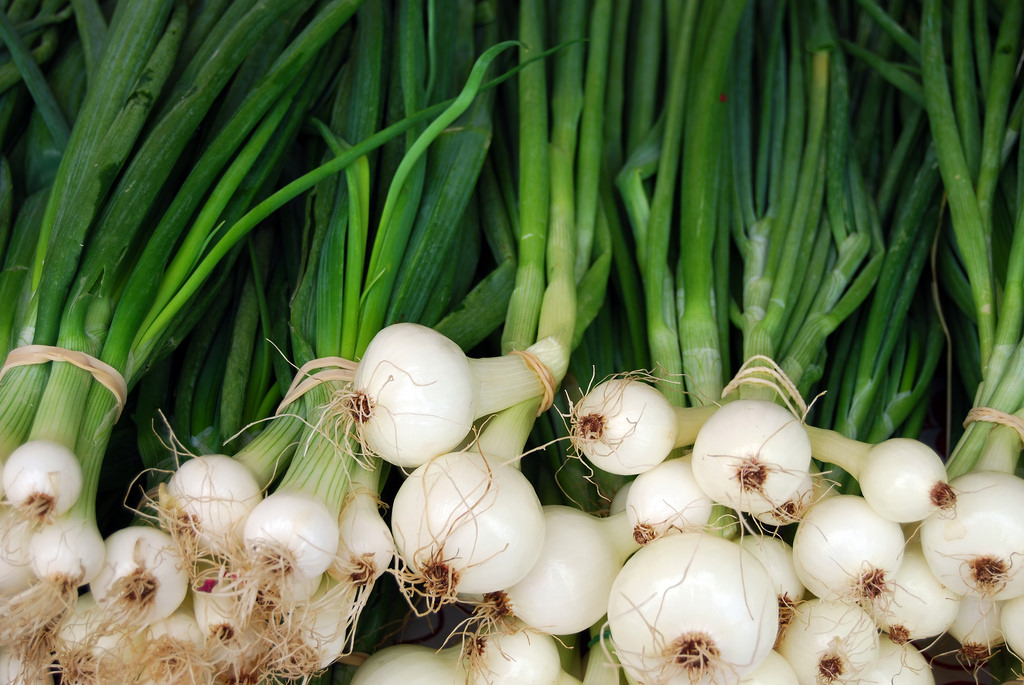By Erika Guzman, Recent ASU Nutrition Student
Green onions. Scallions. Spring onions. All interchangeable names for the delicious fresh green onion vegetable without the overwhelming punch. The colorful green stalks that are perfect for garnish. But have you ever eaten them as a primary vegetable and not just a garnish? Why isn’t it eaten for its benefits rather than just for color or garnish?

Green onions are quite beneficial to your health besides just sprinkling on dishes for color and garnish. They contain heart-enhancing compounds full of vitamins and minerals, perfect for cardiovascular health and lowering coronary heart disease risks. For bone and blood health, a single green stalk has nearly 20mcg of vitamin K; that’s 16% of the recommended dietary allowance! As for vitamin C, there’s about 1.6 mg, or 2% RDA. In Japanese culture and health, it’s believed if you wrap a leek around your neck, it’s supposed to help fight against colds and flu because of the vitamin C and other benefits in it.
Green onions also benefit eye health. It has vitamin A, which is needed for the retinal receptors to absorb light. Another thing that seems to be overlooked is that green onions contain natural quercetin or flavonoids. Quercetin is an antioxidant, just like the antioxidants found in green tea and red wines, and it provides antihistamine and anti-inflammatory benefits when consumed.
Overall, these small vegetable packs in a punch with a number of benefits. The flavor is milder than a regular white or red onion, and it’s a nice starter for picky eaters or people who aren’t as adventurous, even if it does start off as just a garnish. Otherwise, for those who enjoy this vegetable, it’s very cheap and keeps well in the fridge in the crisper and can last about 4 to 5 weeks! So instead of using a stalk or for a boost, why not make it a side dish or a meal? Here are some recipe ideas to enjoy and get the most out of the bunch:
- Beef negimaki
- Cang Ying Tou
- Cebollitas asadas
- Cheesy scallion-stuffed jalapenos
- Chinese scallion pancakes
- Hua Juan
- Korean savory pancakes (pajong)
- Green onion curry
- Green onion naan
- Green onion slaw
- Ginger scallion fish
- Grilled stuffed flank steak with scallions, ginger, and teriyaki sauce
- Saute of Green onions and radish
- Spicy Korean green onion salad
- Spring onion kimchi
- Spring onion soup
The Fill Your Plate website has hundreds of different recipes to choose from. Give your family a variety of options that they will love.
Pexels.com
References
Delange, B. Ph.D. (2015). Vitamin A. Oregon State University. Retrieved at
http://lpi.oregonstate.edu/mic/vitamins/vitamin-A#RAE.
Farmer Foodshare. (n.d.). Green Onions. Farmer Foodshare. Retrieved at
http://www.farmerfoodshare.org/veg/green-onions/.
Fruits and veggies: more matters. (n.d.). Green Onions: Nutrition. Selection. Storage. Fruits &
Veggies, More Matters. Retrieved at https://www.fruitsandveggiesmorematters.org/green-onions.
Kerns, Michelle. (n.d.). Benefits of Green Onions. SF Gate. Retrieved at
http://healthyeating.sfgate.com/benefits-green-onions-7762.html.
Only Foods. (n.d.). Spring Onion. Only Foods. Retrieved at
https://www.onlyfoods.net/spring-onion.html.
Sahul, Deepika. (2012). Health benefits of spring onions. Times of India. Retrieved at

